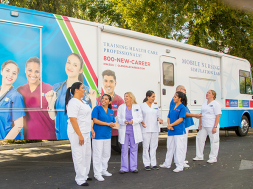
Transformation is the Required Path Forward for Most Colleges and Universities
By Wallace K. Pond, Ph.D., founder, IdeaPathway.com and the Transformation Collaborative™
I have written many articles on the current state (and decade long decline) in higher education, identifying what external factors have precipitated the deep contraction, even before the pandemic, and, importantly, what successful institutions are doing to navigate the incredibly difficult landscape. However, one reality that deserves more attention is the extent to which most traditional institutions of higher education must pursue truly transformative thinking in order to remain relevant, let alone to thrive going forward. And by “traditional,” I mean credit-bearing, degree granting, Title IV institutions. It has nothing to do with profit status or mode of delivery.
In terms of enrollment and the number of providers, the higher education “industry” is about 20% smaller today than it was ten years ago.
If current trends continue – and some, such as demographics, are already baked in for years into the future – the industry will likely be another 20% smaller in 2030. What this means is that the market for credit-bearing, degree granting post-secondary education will include fewer institutions with fewer students overall, and that will fall primarily into a trifurcated market of 1) a small number of extremely wealthy and exclusive institutions, 2) another small number of “mega” universities with six figure enrollments, and 3) the remainder (majority) of colleges and universities, existing somewhere on a spectrum of risk to their operating model and even their very existence.
The reality is that for most colleges and universities in the U.S., the incrementalism of the past, and even the short-term crisis management changes of the pandemic, will not be nearly sufficient to maintain relevance and sustainability over time in the market as it exists now.
Why is this?
Quite simply, higher education is at an existential crossroads in which a combination of external factors (demographics, negative public opinions, cost & debt, the economy, and alternatives to traditional degree programs), have conspired to render the traditional financial and operational models obsolete for a majority of institutions. In fact, about a third of all colleges and universities were operating in the red even before the COVID crisis and roughly 1,300 closed or merged between 2010 and 2020.
This is significant, because it means that many colleges have been operating at a deficit for up to several years and have already employed many of the options at their disposal to preserve liquidity.
They were laying off staff, borrowing money, deferring maintenance, delaying accounts payable, and spending down endowments prior to the current crisis, which has further stretched compromised institutions.
Of potential greater importance, however, is that traditional colleges and universities are built on a model designed to perpetuate the status quo. That same model represents severe structural impediments to addressing both internal and external threats, and thus has to be completely restructured in order to meet the depth and breadth of the current and future challenges putting so many colleges at risk.
| Some Structural Impediments to Change | ||||
|
||||
In short, a majority of colleges and universities must re-evaluate even the most basic and long-standing elements of what they do and how they do it, such as delivering content over academic terms, credit-bearing courses, grades, degrees, faculty control of curriculum, tuition as the primary revenue source, credit transfer and prior learning policies, accreditation as an imprimatur of “quality,” the “one and done” relationship with graduates, and a host of other examples. Institutions that have the capacity and the courage to engage in transformational change will dramatically increase their likelihood of surviving and thriving going forward. Frankly, those colleges in the 85% or so of at-risk institutions that aren’t willing or able to reinvent themselves are likely to end up on a spectrum from marginally relevant to zombie institutions to merged or closed.
So, what next?
| Definition of Transformational Change | ||||
| Transformation is a radical departure from the status quo in an organization, leading to foundational changes in the nature of the entity. This can be cultural, structural, management, behavioral, the business model and market, product strategy and even the organization’s mission and purpose. | ||||
The mega institutions have already engaged in forms of transformative change, the super wealthy and exclusive schools (less than 10% of higher ed) can do mostly what they want, and the remaining 85% or so will be in a street fight for enough students who can pay the bill, either themselves or via some third-party mechanism. Although it is anathema in higher education to say this, the industry has become a retail business on the consumer side and that is one area of necessary reinvention for most institutions. Most students will simply no longer pay exorbitant rates for a poor, high-friction customer experience that requires many years of deference to often irrational institutional rules, that results, even when successful, with a degree that often has marginal relevance and comes with long-term debt! This trend was already in play before the COVID crisis, but the pandemic has accelerated the move away from traditional higher education toward non-credit, non-degree options. Recent research by Strada Education Network found that disruptions to education plans from early in the pandemic have not only not subsided, the number of people who say their plans have changed has actually increased over the last year.
And of critical interest to colleges and universities, of those adults, 18 and older, who intend to pursue some kind of postsecondary education going forward, over 60% said they will choose employer based or online non-college training options.
In fact, only 33% said they would choose a community college or four-year institution when they re-enter education.
The good news is that millions of people will still want (and need) a college degree for the foreseeable future and many millions more will need some form of ongoing postsecondary education. Although traditional higher ed is shrinking, postsecondary, writ large, is growing, and will continue to do so for at least the next couple of decades. It’s obvious then, that a big part of the necessary transformation for many colleges and universities is to completely redefine how they think of the market, whom they serve, what they sell, and how they provide it. In some cases, this means abandoning very long-standing notions about what is “sacred” in the institution. And from a cultural perspective, many colleges and universities have to learn to want to avoid failure more than they want to avoid change.
Why transformative change is so rare
Transformational change usually happens in response to crisis or profound fluctuations in the operating environment that render existing assumptions and operational models ineffective, irrelevant or obsolete. However, because of how difficult transformation is, it is a relatively rare occurrence, even when an entity’s survival is at stake!
| Requirements for Transformation | ||||
|
||||
First of all, very few executive leaders or even leadership teams have the bandwidth or ability to run the daily operation, manage through disruption, and build for the future all at the same time, let alone build for a transformed future. It just demands more than most leaders have ever done. On the other hand, there are many recent examples of leaders who have managed to implement very effective, short-term responses to crisis, while keeping some form of the legacy business operating. Unfortunately, many of those solutions, as effective as they are, have a very short shelf-life and are primarily transactions to solve an immediate problem. They are rarely transformative in nature.
Moreover, in many cases, particularly in higher education, institutions misunderstand what their challenges actually are. Because they are structurally built and have been refined over centuries to preserve the status quo, rather than to engage in transformative change, they perceive their challenges – and solutions – to be within the framework of what’s always been. For example, many institutions see their declining enrollment as a problem with marketing or admissions or pricing, rather than the fact that the value proposition for a growing number of students is not compelling enough and/or the ROI is so dubious, that many potential customers are choosing other providers – including those outside of higher education. Even if a school figures that out, they are highly unlikely to question the role that credit bearing courses and degrees play in the disconnect between what they do and what the market needs. Some things are just off limits – either overtly or covertly.
Ultimately, we will hit an equilibrium point in which fewer colleges are enrolling more students and the supply and demand equation will become more balanced.
Colleges who get into new markets will be well positioned to serve both degree and non-degree students (individually and through B2B engagements), potentially with shared content, learning experiences, credentials, partnerships and other synergistic opportunities that provide a value proposition that enough customers will choose to support a robust business model and sustainability for the institution.
Lastly, in my work with and visibility into hundreds of institutions of higher education over my career – and dozens during the pandemic – it has become clear that many colleges and the people in them misunderstand what transformative change is. They often think that a change in process or technology reflects transformation just because it was hard or expensive or took a long time or resulted in automation, etc. While such initiatives may provide innovation in the sense of a new way of doing something, the something itself rarely changes in a fundamental way. As an example, one institution viewed the adoption of a mostly automated document imaging system for admissions and financial aid as “transformational.” While it was a big difference from students mailing, emailing and faxing documents, which were previously manually put in analog files, then copied digitally one by one, nothing in the admissions or financial aid processes themselves changed. More importantly, nothing changed in what the students were applying for – hundred-year-old model degree programs on the same academic schedule with the same credit-bearing courses, the same multi-year time commitments, the same atrocious credit transfer and prior learning policies, the same faculty-controlled curriculum, etc.
Fortunately, for the few institutions that do understand and have engaged in transformative change, the process itself can be incredibly energizing and validating, particularly in a time of crisis! One client-institution of mine in the Mid-west chose to engage in a completely new strategic planning process that focused on the future, new markets, technology for the student experience, M&A, industry partnerships, diversified revenue streams, non-degree programs, and other items during the heart of the pandemic. What they discovered was that not only did the process and focus energize the university community, it also made them less stressed and anxious about the current crisis!
| Typical Areas of Focus | ||||
|
||||
Transformation is possible, but it requires a deep, long-term, purposeful commitment. It also requires courage on the part of leadership and constituents. The fact is many colleges are neither capable of nor willing to reinvent themselves, but those who are willing, even if not capable solely with internal resources, there is still a way forward. The Transformation Collaborative™ exists to support institutions on their path to reinvention, often in cohort groups that provide mutual encouragement and insights. Genuine transformation is one of the most difficult things a college will ever do, but it may also be the most important.
Wallace Pond, a thirty-five year educator, executive, and entrepreneur, is a founding partner of the Transformation Collaborative™.
WALLACE K. POND, PH.D., founder, IdeaPathway.com and the Transformation Collaborative™, has been a mission-driven educator and leader for over 30 years. For the last 20 years, Wallace has been a senior leader in higher education, holding both campus and system level positions overseeing single and large, multi-campus and online institutions of higher education in the US and internationally. He has served as chancellor, president, COO, CEO, CAO (Chief Academic Officer), and board member, bringing exceptional value as a strategic-servant leader through extensive experience and acumen in strategic planning, transformational change, change management, crisis management/turn around, organizational design and development, P&L, human capital development, innovation, new programs, and deep operational expertise among other areas of impact. His many thought leadership articles are available at www.WallacekPond.com.
Wallace began his career as a high school teacher and adjunct professor, and spent six years in the elementary and secondary classroom working primarily with at-risk youth. He was also a public school administrator and spent another six years as a full time professor and administrator in the not-for-profit higher education sector, working in both on campus and online education, bringing education to underserved students. Additionally, Wallace has over 15 years of executive, private sector experience, creating a unique and powerful combination of mission-driven and business focused leadership and insights.
Contact Information: Wallace K. Pond, Ph.D. // Founder // IdeaPathway.com and the Transformation Collaborative™ // 719-344-8195 // wkp@wallacekpond.com; wallace@transformationcollaborative.net









